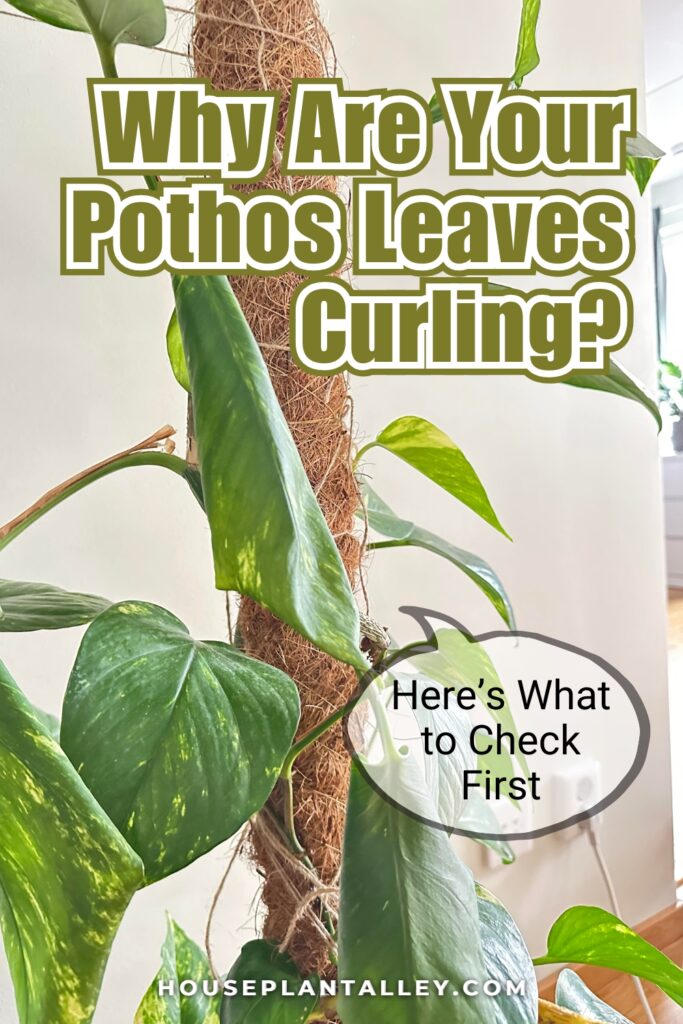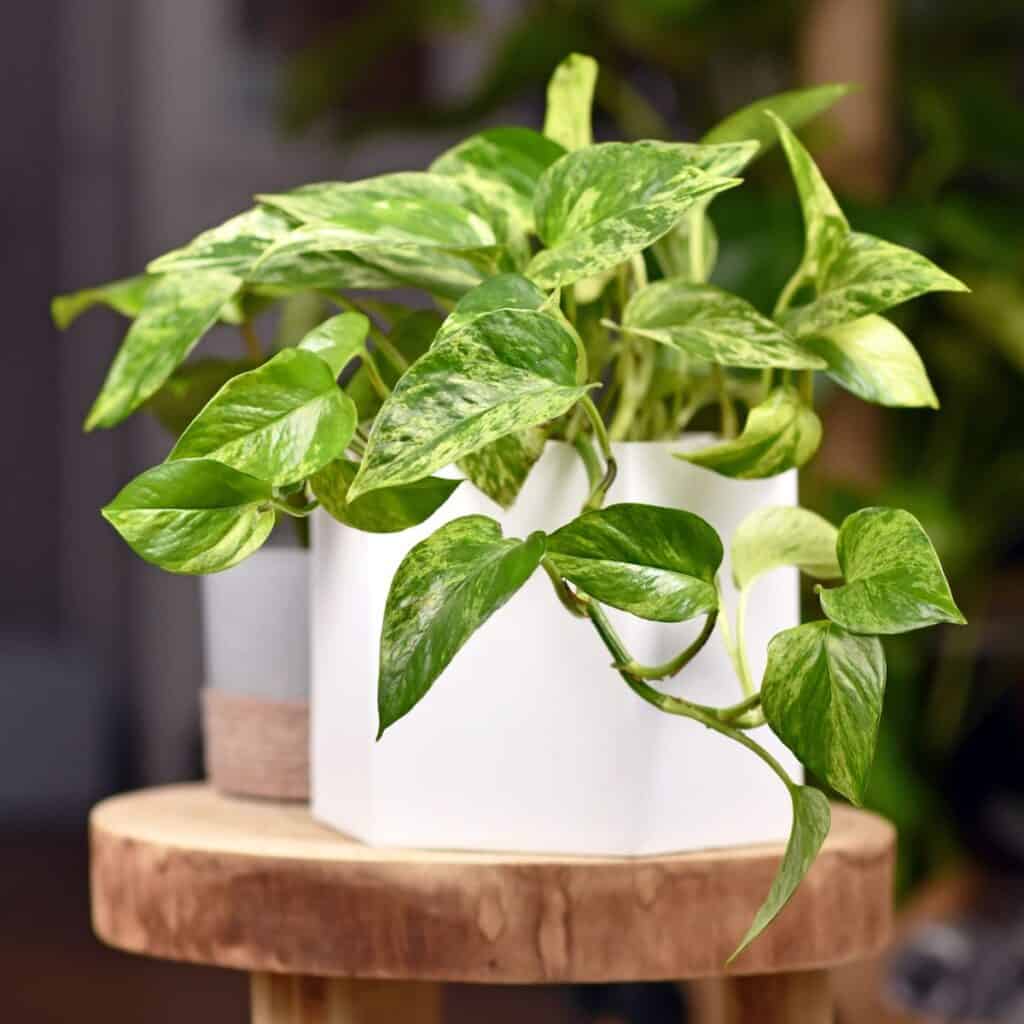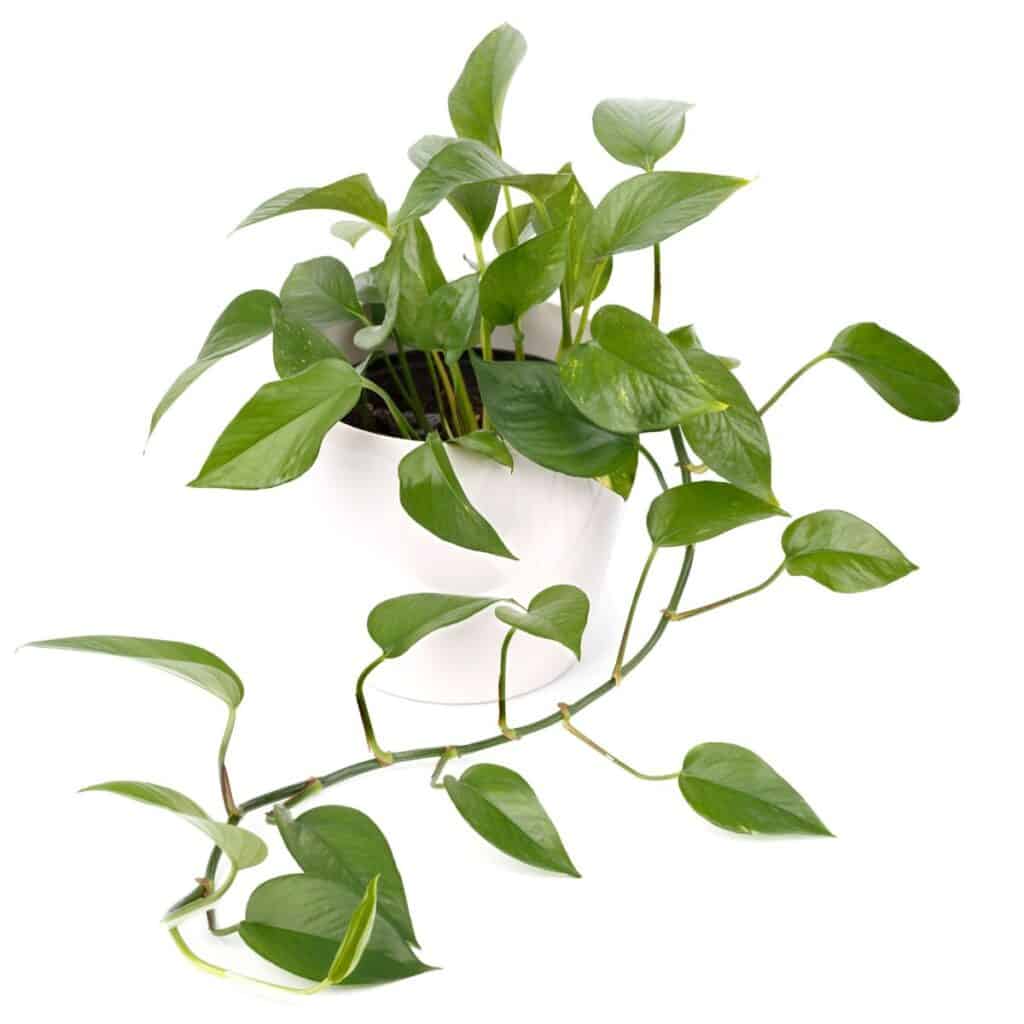Have you ever noticed the leaves of your pothos plant starting to curl up? You may be wondering why this is happening and how to fix it. Pothos leaves curling is a common problem, but luckily there are some easy solutions that can help get your plant looking healthy again! In this article, we’ll explore what causes leaf curling in pothos plants and how to address it so they’re thriving once more.

Why Are Your Pothos Leaves Curling?
Leaf curling is often caused by environmental stressors such as too much or too little light, incorrect watering patterns, a lack of humidity, or an increase in temperature. All these factors can cause water loss from the leaves which leads to them becoming dry and brittle which then causes them to curl up. Understanding what could be causing your particular issue is key to resolving it quickly and easily.
Thankfully, all of these potential problems have simple solutions that don’t require any special tools or knowledge – just some patience! We’ll go through each one step-by-step so you’ll know exactly what to do if your pothos’ leaves start curling up again. So let’s get started on finding out why your plant isn’t doing well and getting it back into tip-top shape!

1 – Underwatering
Did you know that up to 95% of houseplants are underwatered? This means it’s likely your pothos is among the majority. If so, chances are its leaves have started curling as a response to underwatering.
It’s easy for this to happen when caring for plants – especially busy folks like yourself who don’t always have time to stick with a strict watering schedule! But proper hydration is key in keeping your plant healthy and happy. When leaves start curling, it usually signals one thing: The soil isn’t absorbing enough water due to insufficient or improper watering.
To fix this issue, make sure you’re giving your pothos the right amount of moisture it needs rather than leaving it thirsty for days at a time. Check the top inch of soil before adding more water; if it’s still moist from prior watering sessions, hold off until dryness sets in again. Doing this will help revive those troublesome curling leaves and keep them looking green and strong!
2- Overwatering
Watering your pothos plant can be a delicate dance. Too little, and the leaves start to curl in on themselves; too much, and you find yourself with an overwatered plant. Overwatering is like drowning your beloved greenery – it literally soaks up more than it needs, leaving its roots waterlogged and unable to breathe. Excess water has nowhere to go except for sitting in the soil or overflowing from drainage holes — not exactly ideal conditions for most plants!
Your pothos will thank you if you make sure that excess water doesn’t become part of their life story. Allow the soil between watering sessions to dry out slightly before adding any additional moisture – this helps prevent roots from becoming over-saturated with liquid. If your pot does not have any drainage holes, consider repotting into one that does as this prevents standing water which could cause root rot down the line.
3 – Too Much Fertilizer
It’s possible that too much fertilizer is the cause of your pothos leaves curling. Excess fertilizer can lead to a buildup in soil, which can burn plants if not managed properly. Fertilizer burn is characterized by yellowing and wilting of the leaves and may even result in leaf drop.
To avoid this issue, it’s best to use a balanced fertilizer specifically for houseplants, or one with low nitrogen levels to ensure you don’t over-fertilize your plant. Additionally, be sure to follow directions on how often and how much fertilizer should be used when caring for your pothos.
Ultimately, taking care when fertilizing your pothos will help keep its leaves healthy and strong so they’re less prone to curling.

4 – Temperature Stress
The idea that temperature stress could be causing your pothos leaves to curl is a plausible one. After all, it’s not too uncommon for plants to react negatively when exposed to abnormal temperatures or fluctuations in them. So let’s take a closer look and see whether this theory holds up as an explanation of what you’re seeing.
When it comes to temperature stress, the main thing we need to consider is the range of temperatures that are safe for your plant. For example, most pothos like temperatures between 65-75 degrees Fahrenheit; if they go above or below these levels, they can become stressed out. Additionally, sudden changes in temperature—such as when the air conditioning kicks on during the summer months—can cause even more issues. If either of these things has been happening recently, then this might explain why your pothos leaves are curling up.
To test this theory further, try monitoring the environment around your plant more closely over the next few days and weeks: keep track of any extreme temperatures and make sure there aren’t any big swings between hot and cold times of the day. Doing so should help you confirm whether temperature stress is indeed the culprit behind those curled leaves!
5 – Low Humidity
It’s possible that low humidity levels are causing your pothos leaves to curl. Humidity is a major factor in the health of plants and even small changes can have an effect on their growth rate, shape, and size. If you think this could be the case with your plant, then it’s time to take some steps toward increasing the moisture content in the air around it.
When there is not enough moisture available for a plant to absorb, one common consequence is leaf curl – where the tips of the leaves turn up or under as they dry out. This can start happening when the humidity drops below 40%, so if you’re experiencing more extreme temperatures than usual (such as winter cold snaps) then this could cause your pothos’ leaves to become curled. Fortunately, raising humidity levels isn’t too difficult; placing a humidifier nearby or misting the foliage will help keep them looking healthy!
6 – Incorrect Light Exposure
You may have noticed your pothos leaves curling. This could be due to incorrect light exposure, and understanding how this is affecting your plant can help you learn how to keep it healthy and thriving!
Let’s explore why improper light exposure might cause the leaves of a pothos plant to curl. There are several potential causes that include:
- Not enough indirect or direct sunlight – Pothos plants need bright but indirect sunlight for the best growth. A lack of adequate light can lead to curled leaves.
- Too much sun – Too much direct sunlight can cause scorching of the leaves and make them curl up in order to protect themselves from further damage.
- Incorrect positioning near windows – If placed too close to a window, pothos plants may experience extreme temperature fluctuations which can result in leaf curling as well.
It’s important to take care when providing light for your pothos; if they don’t get enough they won’t thrive, while too much will put them at risk of becoming damaged beyond repair. The ideal amount of light needed by a pothos depends on its environment – so regular monitoring and adjusting accordingly is essential.
To ensure proper lighting conditions for your pothos, place it somewhere where it’ll receive bright but indirect light such as near an east-facing window or in a room with good natural lighting during the day. Avoid placing your plant directly under direct sunlight or next to any artificial heat sources like radiators as these environments can lead to excessive amounts of heat damaging their delicate foliage. Make sure you check regularly and adjust the location depending on season changes since different intensities of light are required according to winter/summer months.

7 – Pest Infestation
It’s so easy to take our pothos plants for granted; they are usually some of the toughest houseplants we can find. But sometimes, even these trusty greens can be affected by a pest infestation. In this case, it might just explain why your plant’s leaves have started curling up and turning yellow – an unwelcome change from their usual lush greenness!
Pest infestations occur when bugs or insects feed on your plant’s leaves and sap. This type of problem often results in leaf curling and yellowing as pests suck away essential nutrients from the foliage. It may also cause discoloration, wilting, and premature dropping of leaves. These symptoms tend to worsen over time if left untreated, which is why it’s important to address them right away.
Fortunately, there are several ways you can manage any kind of pest infestation before it gets out of hand. Start with inspecting your pothos carefully for signs of insect activity such as eggs or webs near the stem or base of the leaves. If necessary, use a magnifying glass to get a closer look at its undersides where most pests like to hide. Once you spot any culprits, immediately treat them using natural solutions such as neem oil or insecticidal soap spray — both effective yet less harsh alternatives compared to chemical pesticides. You should also keep monitoring your plant regularly for further signs of damage caused by pests and repeat treatments whenever needed until all traces are gone!
8 – Disease Infestation
Disease infestation is a common cause of pothos leaves curling. While it’s not as fun to think about, there are many types of plant diseases that can affect your houseplant. Fungal diseases and bacterial infections are the most commonly seen in indoor settings. These problems usually start small but they can quickly spread throughout your entire plant if left untreated.
It’s important to take action right away when you notice any signs of disease or infection on your pothos. This can be tricky since some diseases don’t show up until the damage has been done. One way to identify these issues early is by regularly checking for discoloration, wilting, brown spots, or other unusual characteristics in the leaves and stems. If you catch something early enough, you may be able to treat it with an appropriate solution such as fungicides or antibiotics specifically designed for plants.
When dealing with a disease infestation, prevention is key! Keeping your pothos healthy and happy will increase its chances of fighting off potential illnesses before they have time to take hold in its system. Make sure you’re providing plenty of water and light while keeping temperatures consistent and avoiding overwatering which can lead to root rot – all great ways to keep your pothos safe from harm!
9 – New Leaves Curling
New leaves curling is a common issue when it comes to pothos. Take, for example, the case of Jenny’s satin pothos plant: she noticed new leaves were curled and wasn’t sure how to solve this problem.
The most likely cause of her plant’s leaf curl was too much bright light or not enough water. When plants are exposed to excessive sunlight, their leaves can become overly dry; conversely, if there isn’t enough water in the soil, the roots cannot absorb what they need. So make sure your pothos is getting just the right amount of both! To help ensure your plant gets enough hydration and sunshine, try adding some liquid fertilizer every other week (following directions on the label) as well as positioning it near a window that provides indirect light.
Tip
If you’re worried about over-watering your pothos – an easy way to check whether your pot needs more water is by sticking your finger into the soil up to the first knuckle. If it feels moist – then no need to add any more H2O!

10 – Transplant Shock
Did you know that up to 80% of transplants fail due to transplant shock? Transplant shock is a condition caused by the sudden change in environmental conditions for plants when they are moved from one place to another. This can often cause new leaves on pothos plants to curl, as with most other plants.
The best way to prevent this type of shock is to take your time and ensure the soil moisture around the roots remains consistent during and after transplanting. When repotting a pothos plant, use potting soil that keeps its moisture content well-balanced so it’s not too dry or too wet for the plant. Make sure there’s plenty of oxygen in the moist soil which will help reduce stress on the plant while it adjusts to its new home.
Transplant shock can be prevented if care is taken when moving any kind of houseplant, including pothos plants. While some curling may still occur, especially with young plants just arriving at their destination, following these steps should give your beloved pothos an excellent chance at thriving in its new location!
Related Post:
How To Propagate Pothos In Soil
11 – Wrong Container
Planting your beloved pothos in the wrong container is like putting a puzzle piece into the wrong slot – it just doesn’t fit! When this happens, you may start to notice that the leaves of your pothos are curling up. To ensure your plant is happy and healthy, there are two key things to consider when choosing the perfect pot: pots with drainage holes and pots of an appropriate size.
First, make sure that the pot has adequate drainage so that water does not sit on top of or at the bottom of the soil for extended periods of time. If it does, this leads to soggy soil which can cause root rot and lead to leaf-curling as well. Investing in pots with drainage holes or adding some rocks or pebbles at the bottom helps prevent this from happening.
Second, pick containers that are proportionate to a size relative to your pothos’ growth rate; too small a pot could also result in droopy curls as opposed to lush ones due to the lack of nutrients available for absorption by roots cramped within limited space. By being mindful of these two important considerations when selecting a container for our plants we can enjoy their beauty without worrying about any potential problems down the line!
Conclusion
It’s clear that there are a lot of reasons why pothos leaves can start to curl. From underwatering or overwatering to temperature stress and disease infestation, it seems like no matter what we do our plants just don’t want to cooperate! But I think the real problem might be us – maybe we’re trying too hard? Maybe all they really need is some tender loving care and attention, as well as the right environment in which to thrive. After all, if you take good care of your plant, it’ll take care of itself.
So next time your pothos leaves start curling up on ya, before reaching for the fertilizer or worrying about diseases, check out its container first. If you give ’em plenty of air circulation and room to grow, chances are those leaves won’t be curling anymore! And when things seem tough and nothing else works – try talking softly to your plant. It may sound silly but hey – sometimes plants respond better than people do!
In conclusion: caring for plants isn’t rocket science; it takes patience and dedication. So show them some love (and make sure they have enough water), then sit back and watch them flourish!
